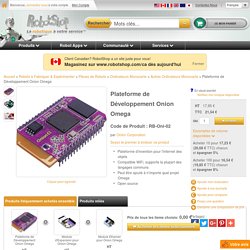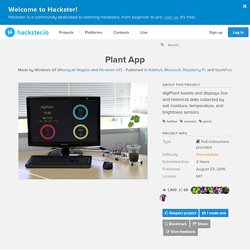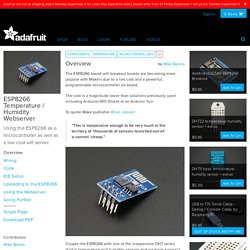

Plateforme de Développement Onion Omega. Plateforme d'invention pour l'internet des objetsCompatible WiFi, supporte la plupart des langages communsPeut être ajouté à n'importe quel projet OmegaOpen source La Plateforme de Développement Onion Omega est une plate-forme d'invention pour l'internet des objets.

Elle est compatible WiFi et supporte la plupart des langages communs, tels que Python et Node.JS. Omega rend le prototypage de matériel aussi facile que la création et l'installation d'applications logicielles. Orange Developer - Live Objects - Getting started. To start with Live Objects API, you should follow the documentation available in each SDK.

Simple use case with a Raspberry Pi Raspberry Pi’s network configuration pi@raspberrypi ~$ sudo nano /etc/network/interfaces auto lo iface lo inet loopback auto eth0 allow-hotplug eth0 iface eth0 inet dhcp auto wlan0 iface wlan0 inet dhcp wpa-ssid "Domino-SSID" wpa-psk "WPAPASSWORD” Sensor program pi@raspberrypi ~$ sudo nano Luxsensor/luxsensor.py Check the log. Hackster. Overview digiPlant is a Universal Windows Platform app that helps users monitor their plant.

The app collects, tweets, and displays temperature, brightness, and soil moisture data from various sensors. It runs on a Raspberry Pi and Windows 10 IoT Core. Hardware Setup The fritzing diagram and the list of materials show how the hardware can be built. MainPage.xaml.cs This page displays live data that are collected by the various sensors within ellipses. TwitterPage.xaml.cs This class allows users to be able to have their plant tweet status.
SensorDataProvider.cs This class creates all of the sensor objects. Customizing LilyPad LED Colors. Feeling Limited?

Are you tired of the same old seven colors? We hear you. Is your creativity outpacing current LED technology? Of course it is! Are you ready to throw convention to the wind and invent your own LilyPad flavors? Sometimes a project demands a really specific shade of light, and if you want that special color, but don’t need the colors of the project to change or cycle, using RGB LEDs means paying extra money for features you don’t need! Node-RED. NodeMCU custom builds. ESP8266 Temperature / Humidity Webserver. The ESP8266 based wifi breakout boards are becoming more popular with Makers due to a low cost and a powerful, programmable microcontroller on-board.

The cost is a magnitude lower than solutions previously used including Arduino+Wifi Shield or an Arduino Yun. To quote Make publisher Brian Jepson: “This is inexpensive enough to be very much in the territory of ‘thousands of sensors-launched-out-of-a-cannon’-cheap.” Couple the ESP8266 with one of the inexpensive DHT series digital temperature and humidity sensors and we have a project that may literally be deployed anywhere to broadcast sensor data. The broadcasting used in this tutorial is using the ESP8266 web server code and respond to web requests (like in a browser or a web client) to return temperature and humidity data (in a REST type format).
Save The World One Drop At A Time, Part 1: Monitoring Water Flow - Plumbing Free - Using A Piezo And Pinoccio Mesh Networking. Water is cheap, but California is in one of the worst droughts ever right now.

Let's face it: we can't fix the drought. However, some CA residents are actively running out of drinking water. At the municipal level it's difficult to enact immediate change, but we can change how we use our water at home. I decided it would be a good idea to focus my energies and the resources of my Artist Residency at Pier 9 towards something we can change: our habits. It's possible to dramatically change our behavior simply by making us aware, but we simply don't know where our water goes. While searching for inspiration, I came across an awesome instructable by StaceyK, where you use a piezo sensor to listen to the water flowing out of a faucet or tap, and translate that vibration data to fluid flow.
So I thought, why not place these all over your house? This was my final project for the Artist In Residence program at Pier 9, and I am pleased to present my learnings. Table Of Contents: 1. Microstack – Shop. Streaming Your Webcam w/ Raspberry Pi. [Last updated on Feb. 2. 2013 for (2012-12-16-wheezy-raspbian) Kernel Version 3.2.27+] Three years ago, we bought two small Webcams and since we wanted to use them on Linux and OS X, we went with the UVC and Mac compatible Creative LIVE!

CAM Video IM Ultra. This Webcam (Model VF0415) has a high-resolution sensor that lets you take 5.0-megapixel pictures and record videos at up to 1.3-megapixel; supported resolutions include 640×480, 1290×720, and 1280×960. If you like, you can go back and read what I was thinking about the IM Ultra, back in 2009. Today, it’s not much used anymore, but may just be the right accessory for a Raspberry Pi.
With the USB Camera attached to the Raspi, lsusb returns something like this: Using the current Raspbian “wheezy” distribution (Kernel 3.2.27+), one can find the following related packages, ready for deployment: Technical Machine.